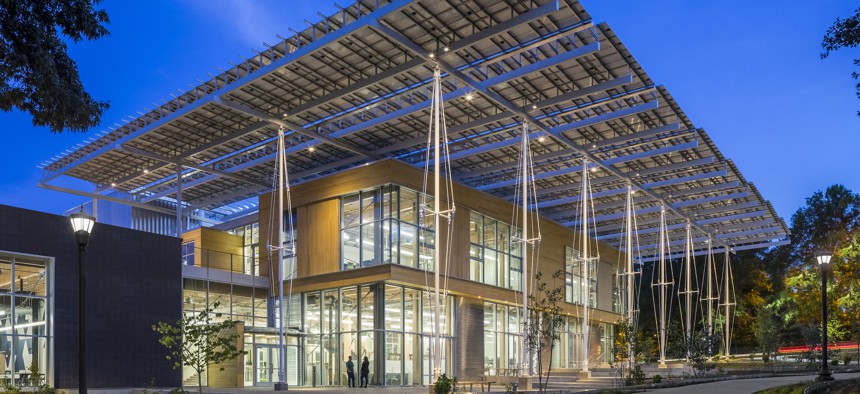A Federal Program Looks to Connect Smart Buildings with Smart Policy

The Department of Energy estimates that by 2030 smart buildings like the Kendeda Building in Georgia could cut 80 million tons of carbon emissions each year. Image courtesy of Georgia Tech
COMMENTARY | Buildings drive a third of the nation’s emissions. Smart buildings can change that with the right policies and programs in place.
Buildings use 40% of the nation’s energy and 75% of its electricity, accounting for 35% of the nation’s annual carbon emissions, according to the U.S. Department of Energy.
Fortunately, homes and buildings are getting energy smart, but without the right utility policies and programs in place, their ability to deliver benefits to the grid and help cities and states meet ambitious climate goals may be limited.
That’s where the DOE’s Connected Communities funding program comes in. It aims to prove the capabilities of smart buildings, demonstrate their value, and help utilities and state and local governments design and implement programs that make the most of energy-smart buildings.
Smart Communities
Energy-smart Buildings that use smart controls, sensors and analytics to communicate with the electrical grid are popping up all over the place. These grid-interactive efficient buildings reduce energy demand while maintaining the comfort of the building occupants, lower utility bills and reduce grid system costs.
The Soleil Lofts project in Utah, for example, is a 600-unit all-electric complex that has 5 megawatts of solar, a battery in every apartment, and 150 EV chargers—all wired up as a “virtual power plant” to provide grid services to Rocky Mountain Power. National homebuilder KB Home is building homes in Menifee, California, that are equipped with solar and energy storage, and will test bidirectional EV chargers that allow electric cars to supply power to homes during an outage.
While these new electric technologies are attractive to home builders and residents, they will have limited value to the grid if their smarts aren’t part of utility programs. The purpose of the Connected Communities initiative is to make that connection.
The initiative, which launched in 2021, seeks to “advance the state of the art for grid-interactive efficient buildings and demonstrate effective ways to move forward on demand flexibility and incorporation of distributed energy resources (DERs), to provide grid services while decarbonizing our buildings and electric grid.”
Connected Communities brings together a cross-section of building industry stakeholders including utilities, local and state governments, demand response aggregators, technology firms, renewable energy and storage providers, homebuilders, end-users, educational and research organizations, and several national labs, including Berkeley Lab as the national coordinator.
Proving the Concept
To prove the concept in the field, DOE has selected 10 projects around the country to participate in a $61 million, five-year demonstration. The initial cohort of projects had its daylong launch event at Ohio State University on November 2.
Soleil Lofts, the KB Home project, and eight others will use smart thermostats, smart water heaters, batteries, and other technologies to interact with the electric grid and coordinate electric demand flexibility across connected sets of buildings. The projects span building and community types, from apartments and single-family homes to large commercial buildings, municipal buildings, and college campuses.
On the West Coast, the Electric Power Research Institute (EPRI) will work with the utility Seattle City Light to demonstrate how a hybrid dual-fuel battery and thermal energy storage approach can maintain critical energy services in the face of extreme weather events for multifamily low-income housing. The project will also establish “resilience stations” in each location that will provide critical services during emergency events.
In rural New Hampshire and Maine, a cohort will test the Transactive Energy Service System (TESS) in potentially more than 400 buildings. The software will connect and control a range of distributed energy resources, including electric batteries, EV chargers, heat pump-based heating, ventilating and air conditioning (HVAC), and solar power.
If the Connected Communities concept proves viable, the potential is huge. A recent DOE study estimated that by 2030, grid-interactive buildings could save up to $18 billion per year in power system costs and cut 80 million tons of carbon emissions each year. That is more than the annual emissions of 50 medium-sized coal plants or 17 million cars.
Elizabeth Stuart is a program manager, and Bentham Paulos is an affiliate in the Electricity Markets and Policy Department, at Lawrence Berkeley National Laboratory.
NEXT STORY: Long-term digital solutions can offset workforce shortage gaps





